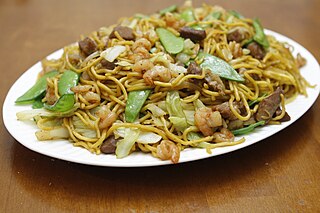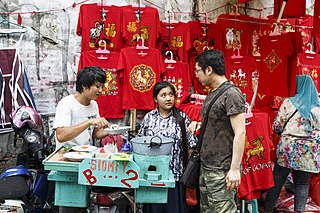
Beef noodle soup is a noodle soup made of stewed or braised beef, beef broth, vegetables and noodles. It exists in various forms throughout East and Southeast Asia.

Pancit, also spelled pansít, is a general term referring to various traditional noodle dishes in Filipino cuisine. There are numerous types of pancit, often named based on the noodles used, method of cooking, place of origin, equal and constant diameter or the ingredients. Most pancit dishes are characteristically served with calamansi, which adds a citrus tang to the flavor profile.

Penang cuisine is the cuisine of the multicultural society of Penang, Malaysia. Most of these cuisine are sold at road-side stalls, known as "hawker food" and colloquially as "muckan carts". Local Penangites typically find these hawker fares cheaper and easier to eat out at due to the ubiquitousness of the hawker stalls and that they are open for much of the day and night. Penang island. On February 22, 2013, Penang was ranked by CNN Travel as one of the top ten street food cities in Asia. Penang has also been voted by Lonely Planet as the top culinary destination in 2014.

Noodle soup refers to a variety of soups with noodles and other ingredients served in a light broth. Noodle soup is a common dish across East Asia, Southeast Asia and the Himalayan states of South Asia. Various types of noodles are used, such as rice noodles, wheat noodles and egg noodles.

Chinese Indonesian cuisine is characterized by the mixture of Chinese with local Indonesian style. Chinese Indonesians, mostly descendant of Han ethnic Hokkien and Hakka speakers, brought their legacy of Chinese cuisine, and modified some of the dishes with the addition of Indonesian ingredients, such as kecap manis, palm sugar, peanut sauce, chili, santan and local spices to form a hybrid Chinese-Indonesian cuisine. Some of the dishes and cakes share the same style as in Malaysia and Singapore, known as Nyonya cuisine by the Peranakan.

Rice vermicelli is a thin form of noodle. It is sometimes referred to as "rice noodles" or "rice sticks", but should not be confused with cellophane noodles, a different Asian type of vermicelli made from mung bean starch or rice starch rather than rice grains themselves.

Lo mein is a Chinese dish with noodles. It often contains vegetables and some type of meat or seafood, usually beef, chicken, pork, or shrimp. It may also be served with wontons, and it can also be eaten with just vegetables.

Filipino Chinese cuisine is a style of Filipino cuisine influenced from Chinese cuisine, historically brought to the Philippines by Chinese Filipinos, starting with the Sangley Chinese and their Chinese mestizo descendants and modern descendants in the Chinese Filipino community of the Philippines. It is characterized as a fusion of Fujian/Hokkien cuisine and Cantonese cuisine adapted over the centuries to Filipino cuisine to suit the general Filipino palate/taste.

Mee pok is a Chinese noodle characterized by its flat and yellow appearance, varying in thickness and width. The dish is of Chaoshan origin and is commonly served in the Chaoshan region of China and countries with a significant Chaoshan Chinese immigrant population such as Singapore, Malaysia and Thailand. Mee pok is commonly served tossed in a sauce, though sometimes served in a soup. Meat and vegetables are added on top.

Bakmi or bami is a type of wheat based noodles derived from Chinese cooking tradition. It was brought to Indonesia by Chinese immigrants from Southern Chinese provinces like Fujian. It is typically prepared seasoned in soy sauce and topped with pork products, which is often substituted for other protein sources in predominantly Muslim Indonesia. Chinese-style wheat noodles has become one of the most common noodle dishes, especially in Southeast Asian countries which have significant Chinese populations and known by various names.

Ma Wen-lu, known in the Philippines as Ma Mon Luk, was a Chinese immigrant best known in the Philippines for his eponymous restaurant, and for being the popularizer and alleged creator of mami and popularizer of siopao.

Lor mee is a Chinese Hokkien noodle dish from Zhangzhou served in a thick starchy gravy. Variants of the dish are also eaten by Hokkiens in Singapore, Indonesia, Malaysia and Thailand. In the Philippines, the local variant is called Lomi or Pancit Lomi. The thick gravy is made of corn starch, spices, meat, seafoods and eggs. The ingredients added into the noodles are usually ngo hiang, fish cake, fish, round and flat meat dumplings, half a boiled egg, and other items depending on the stall and the price paid. Vinegar and garlic can be added as an optional item. Lor Mee can be served together with red chili. Traditional versions also include bits of fried fish as topping though few stalls serve this version anymore.

Batchoy, alternatively spelled batsoy, is a Filipino noodle soup of pork offal, crushed pork cracklings, chicken stock, beef loin, and round noodles. The original and most popular variant, the La Paz batchoy, traces its roots to the Iloilo City district of La Paz, in the Philippines.

Lomi or pancit lomi is a Filipino dish made with a variety of thick fresh egg noodles of about a quarter of an inch in diameter, soaked in lye water to give it more texture. Because of its popularity at least in the eastern part of Batangas, there are as many styles of cooking lomi as there are eateries, panciterias or restaurants offering the dish. Variations in recipes and quality are therefore very common.

Cart noodle is a noodle dish which became popular in Hong Kong and Macau in the 1950s through independent street vendors operating on roadsides and in public housing estates in low-income districts, using carts. Many street vendors have vanished but the name and style of noodle endures as a cultural icon.

Wonton noodles is a noodle dish of Cantonese origin. Wonton noodles were given their name, húntún, in the Tang Dynasty. The dish is popular in Southern China, Hong Kong, Indonesia, Malaysia, Singapore and Thailand. The dish usually consists of egg noodles served in a hot broth, garnished with leafy vegetables and wonton dumplings. The types of leafy vegetables used are usually gai-lan, also known as Chinese broccoli or Chinese kale. Another type of dumpling known as shui jiao (水餃) is sometimes served in place of wonton. Shrimp wonton are mostly known as Hong Kong dumplings. The wontons contain prawns, chicken or pork, and spring onions, with some chefs adding mushroom and black fungus. In Indonesia especially in North Sumatra, West Kalimantan and South Sulawesi, wonton noodles are called mie pangsit.

Pancit Molo or Filipino pork dumpling soup, is a type of soup using wonton wrappers which originated from Molo district in Iloilo City, Philippines. It consists of a mixture of ground pork wrapped in molo or wonton wrapper, shredded chicken meat, and also shrimp. The piping-hot soup is often ladled into serving bowls, and garnished with green onions and fried garlic bits for another layer of flavor. Pancit, which loosely translates to "noodle" is a common cuisine in the Philippines. The "noodle" acting in this dish comes from the wonton wrappers added to this dish, which draws from Chinese cuisine. Under this influence, the wontons within the soup have been compared to "siomai dumplings."

Maki mi, also known as pork maki or maki soup, is a Filipino thick pork tenderloin soup originating from the Chinese-Filipino community of Binondo, Manila. It is made from lean pork tenderized by a meat mallet. It is marinated in soy sauce, garlic, black pepper, rice wine or vinegar, and onions before being covered with egg whites or starch. It is then cooked in boiling beef stock, with beaten eggs dropped and stirred until they form strands. Egg noodles (mami) are also commonly added. The name "maki mi" takes its name from Hokkien Chinese, meaning meat soup noodles.

Indonesian noodles are a significant aspect of Indonesian cuisine which is itself very diverse. Indonesian cuisine recognizes many types of noodles, with each region of the country often developing its own distinct recipes.




















